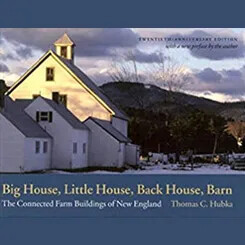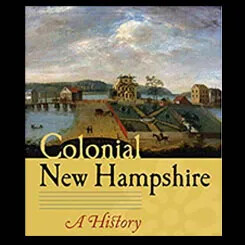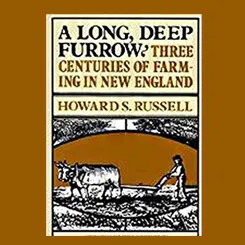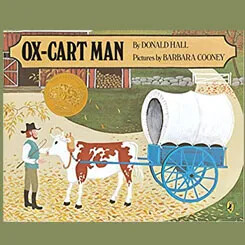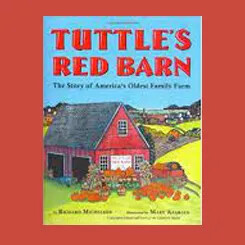Self-Sufficient Farming
What agricultural pursuits characterized the typical New Hampshire farm in colonial times?
The arrival of more and more people in the 1630s and 1640s altered these communal practices. The hundreds of men and women who started coming to New Hampshire were not intending to make their fortunes and leave. Instead, their intent was to settle permanently in the area, which meant they needed to develop stable, long-term methods to produce enough food to support a growing population. At the same time, they began to shift away from communal farming and toward family farming with an emphasis on individual property rights and self-sufficiency.
Farmers faced a number of challenges in New Hampshire. There was no shortage of land but producing reliable yields from the land was another matter. Neither the geography nor the topography was hospitable for farming. The landscape was full of trees, and the soil was rocky and sandy, particularly in the seacoast region, where English settlement was concentrated until the 1720s. A high water table kept the ground soggy as well, making it difficult to plant crops. Farm families spent years, decades even, clearing fields for planting, but then planting brought its own challenges. New Hampshire’s climate, then and now, offers a short 4–5 month growing season, which ultimately limits output. Farmers were also limited in the types of crops they grew. Experiments with traditional English cereal crops proved disappointing. They planted oats, barley, and rye, but only corn grew well in the seacoast region.
In addition to growing cereal crops, early colonial farmers produced a wide variety of goods from the natural resources around them.
- Fruit, mainly apples and berries, did well in New Hampshire and provided some variety to their limited diets. Apples and pears in particular flourished, and many colonists planted extensive orchards with seedlings brought from England. Cider remained the most popular drink in New England well into the 19th century. The berries native to the region also proved plentiful.
- Kitchen gardens produced vegetables such as peas, turnips, parsnips, onions, lettuce, cucumbers, asparagus, beans, squash, and, surprisingly, melons, especially watermelons.
- Fish and game (deer, turkey, pheasant, quail, rabbit) also proved reliable sources of sustenance.
- All farms kept livestock for a variety of purposes. Chickens produced eggs, sheep provided food and wool for the production of textiles, hogs and pigs were a common foodstuff, goats and cows generated milk and other dairy products, while cows also provided a source for leather and served as beasts of burden to pull plows and wagons.
- Bees were kept to produce honey, a more economical sweetener than sugar, which needed to be imported from the West Indies.
- Learning from the Abenaki, many farmers tapped maple trees and produced syrup, although it took, on average, 40 gallons of sap to produce just one gallon of syrup. Maple syrup was another alternative sweetener that was cheaper than sugar, even if labor-intensive to produce. The typical farmer might tap more than 1,000 trees every winter to harvest the needed sap.
- Farmers living in the seacoast region also harvested salt from the great salt marshes that were native to the area.
In addition to generating food, farmers also cut large quantities of lumber. New Hampshire’s lush forests seemed to offer an inexhaustible supply of trees, but the settlers’ need for lumber was inexhaustible as well. Wood was used for almost everything: boxes, crates, barrels; tools, wagons, farm implements; furniture; houses and outbuildings; household items like plates and bowls; and fences, which were needed to mark boundaries, contain livestock, and protect crop fields and gardens. (Although some fences were made from the rocks cleared from fields, most fences during the colonial period were wooden. New Hampshire’s iconic stone walls were not widely used until the early 19th century.) In addition, the average colonial household required 40 cords of wood a year just for cooking and heating. Chopping wood was a continuous task for farm families.
By engaging in these wide-ranging activities, most New Hampshire families survived and even thrived. The birth rate was high, especially compared to England, and these large families worked together to keep their farms productive. Labor came overwhelmingly from within the family.
Most of what farm families produced, they also consumed. New Hampshire farming is typically called “subsistence farming,” but that term implies a minimal output and a struggle to survive. In truth, New Hampshire farms were more successful than that. Most farms reliably produced enough to support large and growing families and could depend on farming to ensure the family’s economic independence. New Hampshire farming was more accurately described as self-sufficient than subsistence.
The colony’s more successful farmers produced not only enough for their families but also enough to sell a small amount of goods at market. Portsmouth and Boston both became centers of economic activity as New Hampshire farmers sold fish, cattle, or lumber to merchants who then shipped these goods to places as far away as the West Indies and Europe. New Hampshire was the major New England producer of all three commodities throughout the colonial period. In this way, New Hampshire’s independent farmers were connected to the larger world of Atlantic trade.
As children grew and families expanded, the need for more land became a matter of constant concern, pushing the colonists to move further and further west. This expansion was also fueled by a steady stream of new arrivals from Massachusetts throughout the colonial period (a migration pattern that continues even today). By the 1720s, colonists had begun to settle in the Merrimack River Valley and, a few decades later, the Connecticut River Valley. These areas were better suited to agriculture, although there was no escaping the hilly terrain, the rocky soil, the abundant trees, and the short growing season. Nevertheless, crops that had struggled in the seacoast region, such as rye, wheat, barley, and oats, did better further inland. In fact, the Connecticut River Valley became known as the “bread basket of New England.” Corn remained the predominant cereal crop, though, until the end of the 19th century.
New arrivals to New Hampshire in the 18th century also brought new kinds of crops. The Scots-Irish, who began settling in the Merrimack River Valley near Londonderry in the 1720s, relied heavily on potatoes and other root vegetables for sustenance. New Hampshire often boasts of being the “birthplace” of the potato in North America, courtesy of the Scots-Irish who arrived at that time. Whether or not the first potato in America was planted in Londonderry, the Scots-Irish in the region certainly did much to promote the growing of potatoes in New Hampshire, producing large quantities of the vegetable and developing other uses for it, such as the production of starch as a stiffening agent for textiles. Whiskey distilleries that relied on potatoes (rather than grain) as a prime ingredient became common in New Hampshire as well.
The Scots-Irish also planted large amounts of flax, which they used to make linen. Londonderry became renowned for its fine linen production in the mid-18th century, a skill developed by the area’s Scots-Irish women. In addition to linen, flax was used to make highly durable rope. The plant also produced flaxseed and linseed oil, widely used in cooking, to feed livestock, and as a lubricant for machinery. These new crops gave a greater variety to New Hampshire farms but didn’t fundamentally change the nature of agriculture. New Hampshire farms still needed to produce a wide variety of products to thrive, rather than specializing in so-called cash crops, like tobacco or cotton (grown in the South) or wheat (grown in the Midwest). And the majority of what farm families generated on their farms still went to support the families themselves rather being sold at market.
The proliferation and stability of New Hampshire’s family farms made the colony predominantly middle class. Outside of Portsmouth, New Hampshire was overwhelmingly rural, with no other major population centers developing until the middle of the 19th century. For most of the people of New Hampshire, life followed the rhythm of the seasons. Community activities, such as church, school, and town meeting, were all structured around the agricultural calendar. Nearly every member of the community, aside from the minister, made their living through agriculture. It was a hard, labor-intensive life, but it offered opportunities for economic independence that were undreamed of in England or anywhere else in Europe.
By the second half of the 18th century, many New Hampshire farms had become established agricultural operations, and most farm families had successfully negotiated the challenging early years when fields needed to be cleared, fences and houses built, and herds of livestock established. The success of these farming operations can be seen in the architecture of the period, as small, simple cabins gave way to sprawling farm complexes. When a farm was being cleared, colonists tended to build one- or two-room houses to provide living quarters and small barns to provide shelter for livestock. As farms prospered, families typically built much larger houses that were connected to the small, original houses to accommodate the growing number of children or the multi-generational nature of many households. A farm’s original barn was often replaced with a much larger one as the size of the livestock herds expanded. The result was a series of buildings known as a connected farm, or “big house, little house, back house, barn.” These types of farm complexes became popular in the mid-18th century. Although common all over New England, connected farms were particularly popular in Vermont, New Hampshire, and Maine, probably because the cold temperatures prompted people to build these linked structures that allowed them to pass from the house to the barn without going outside in the winter.
During the long New Hampshire winters, farmers found other pursuits to occupy themselves. Men often developed skills to become cordwainers, coopers, silver- or tinsmiths, or furniture makers in the off-season, while women frequently spun thread, wove textiles, and sewed clothing. The products they made were used by their families but also afforded them a means to barter or exchange with other farm families in the town.
This barter economy predominated throughout New Hampshire’s colonial period, and people seldom had money on hand. Even a community’s minister often found himself paid in food, clothing, or wood instead of currency. What little commerce there was in farming communities tended to be conducted on the local level, and if bartering wasn’t an option, farmers relied on credit, which was extended to them based on their reputations within their own communities. Both the barter and credit economies were systems based on personal relationships.
